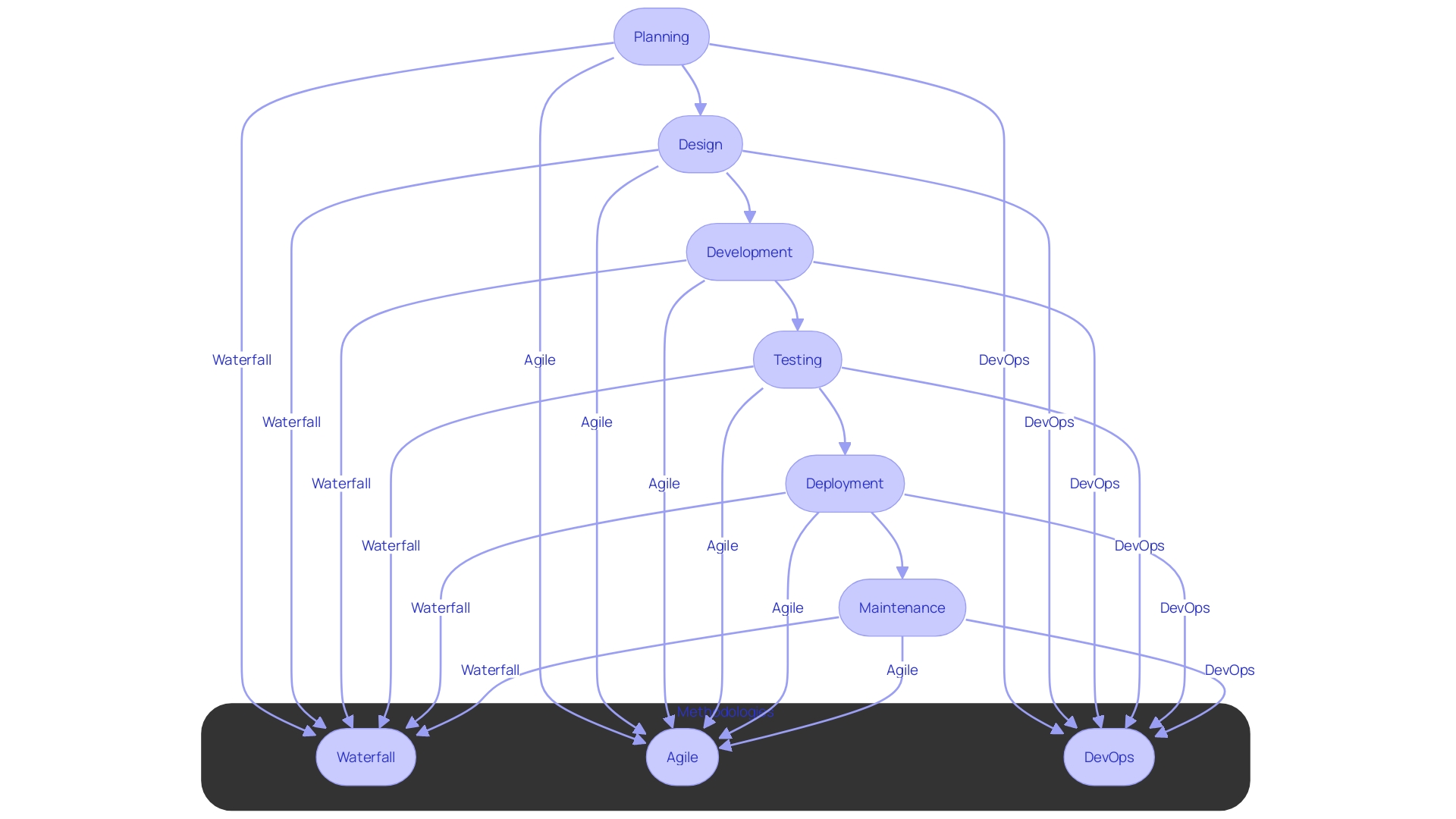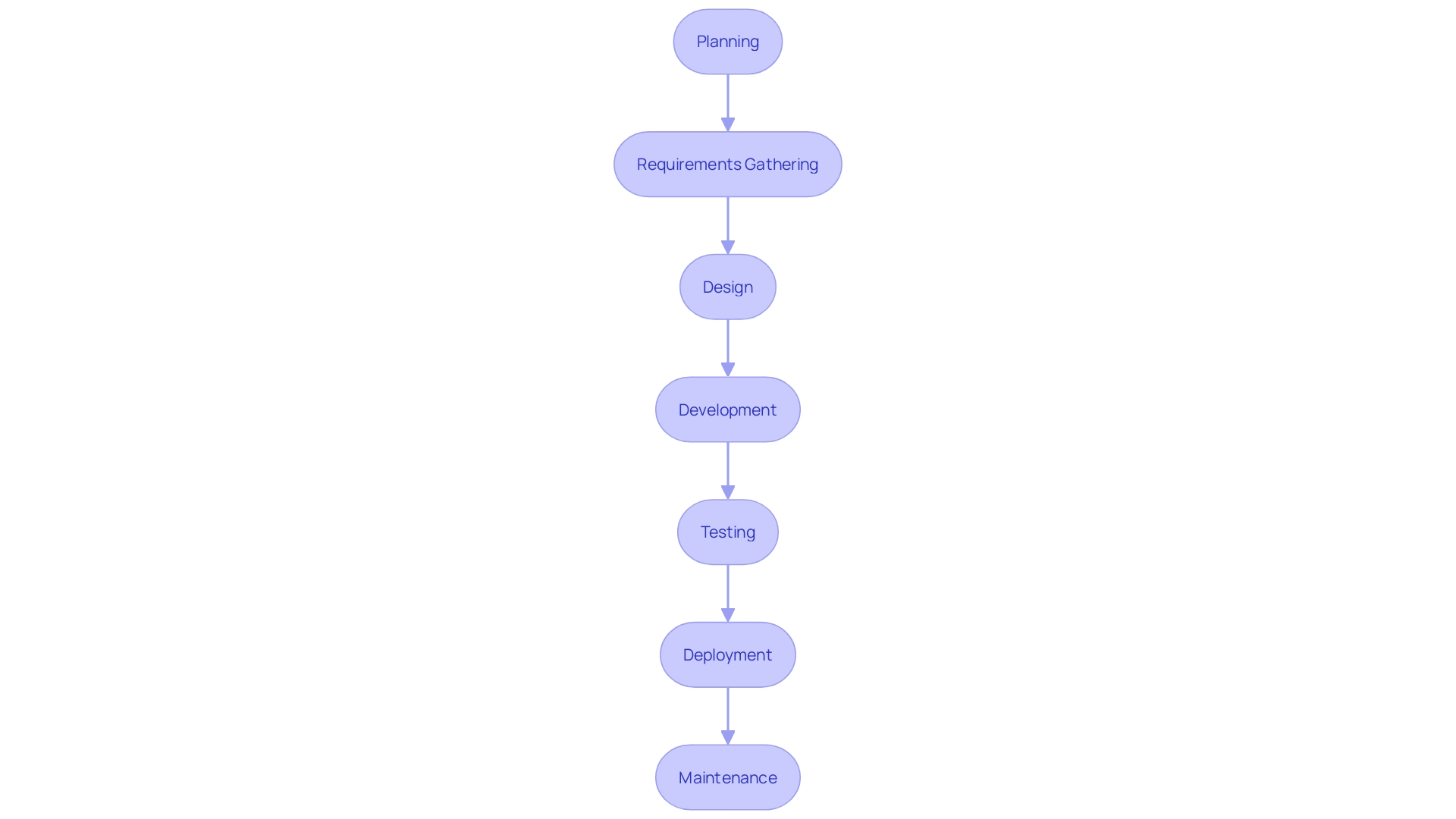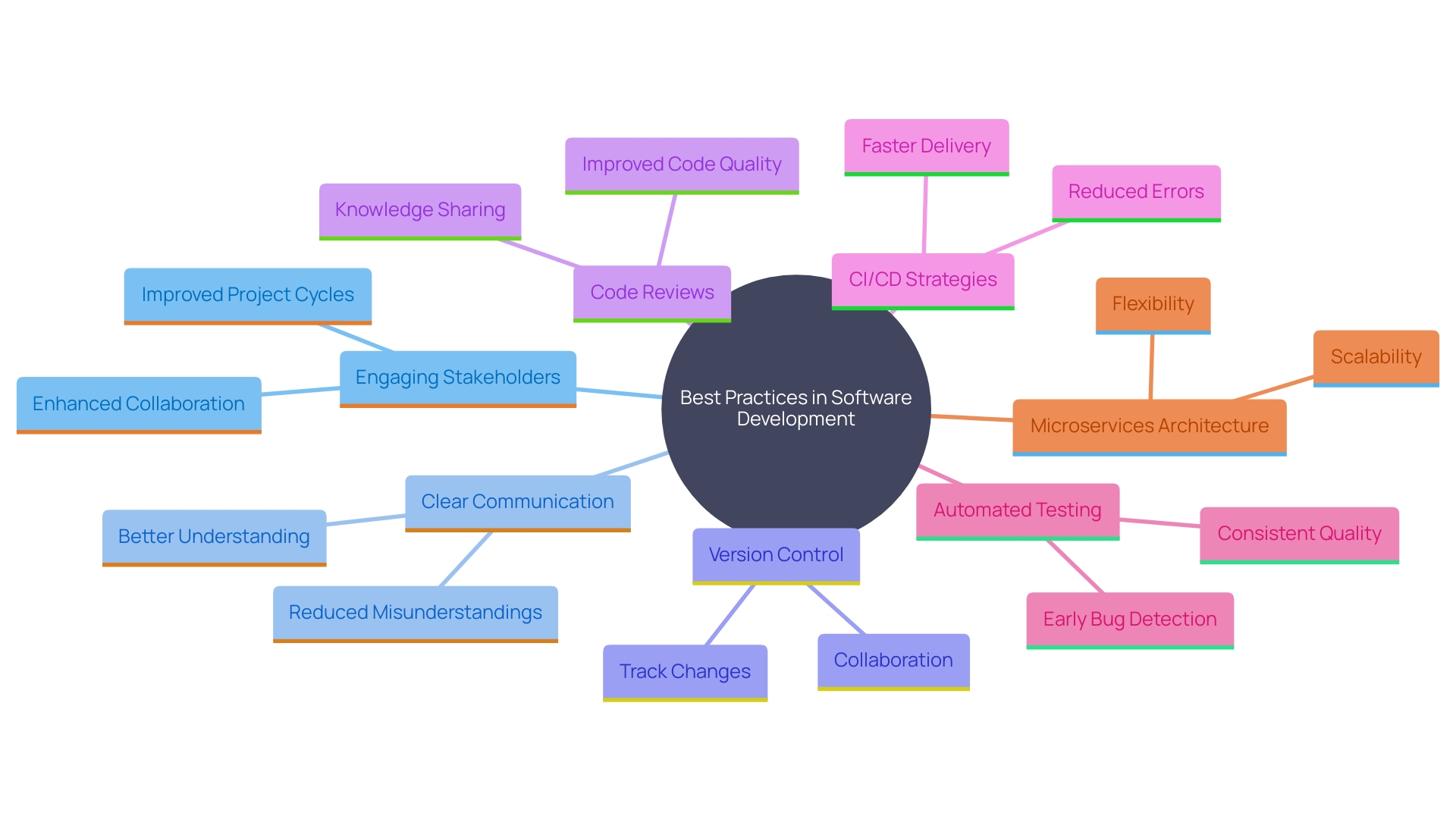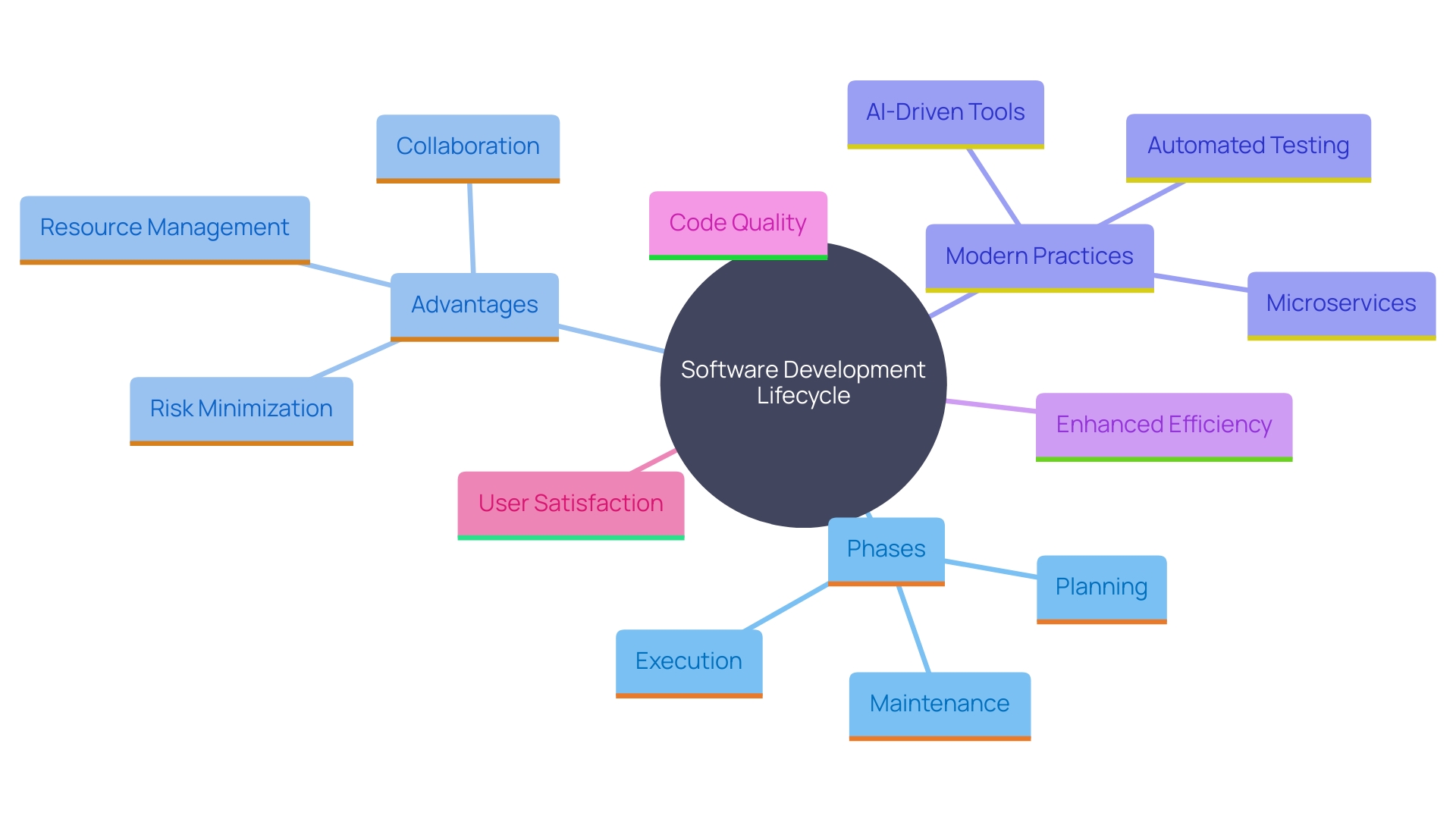Introduction
Navigating the complexities of software development demands a robust framework, and the Software Development Life Cycle (SDLC) serves as the cornerstone for achieving this objective. By guiding the creation of software applications through a series of well-defined phases, SDLC ensures quality and efficiency at every step. This methodology not only aligns software projects with strategic business goals but also mitigates risks and fosters strong leadership.
As the industry continues to evolve with technological advancements and shifting market demands, mastering the SDLC becomes indispensable for delivering scalable, efficient, and high-quality software solutions.
What is SDLC?
The Software Development Life Cycle is a crucial framework that directs the development of applications through a series of clearly outlined stages. This structured approach not only ensures quality and efficiency at each stage but also helps manage the increasing complexity in contemporary application development. As the industry progresses with technological innovations and shifting market needs, comprehending and applying the software development life cycle becomes essential for providing strong, scalable, and effective solutions.
SDLC methodologies offer managers the tools to align software initiatives with strategic business objectives. By following these methodologies, teams can mitigate risks, maintain clear objectives, and ensure strong leadership to keep endeavors on track. This systematic approach also facilitates the documentation and sign-off processes, ensuring that all stakeholders are aligned with the initiative's requirements and implementation.
In the realm of tailored application creation, the adaptability provided by the system life cycle enables the modification of different project management techniques to satisfy particular requirements. Whether it's a traditional waterfall model or an Agile framework, the key is to balance structure with flexibility to deliver high-quality applications that meet user requirements.
Furthermore, the incorporation of contemporary methods like DevOps within the system lifecycle framework improves the effectiveness of application creation. DevOps emphasizes automated testing and monitoring, which ensures code quality and quick resolution of production issues. By adopting these practices, organizations can achieve more adaptive and resilient creation processes.
In summary, the system development life cycle offers a thorough method for managing application development initiatives, ensuring that teams can deliver high-quality applications while effectively navigating the complexities and challenges of contemporary technology environments.

Phases of the SDLC
The Software Development Life Cycle (SDLC) is an intricate journey through several phases, each indispensable to the endeavor's ultimate success. These phases encompass Planning, Requirements Gathering, Design, Development, Testing, Deployment, and Maintenance. Each stage is interdependent, forming a cohesive framework that ensures the delivery of robust, scalable, and efficient software solutions.
Planning sets the foundation by establishing clear objectives and defining the scope of the endeavor. Effective management during this phase ensures that the project stays on track, aligning with organizational goals. Requirements Gathering follows, capturing the needs of stakeholders to ensure that the final product meets user expectations and business objectives.
The Design phase converts these requirements into detailed blueprints, outlining the architecture and components of the system. Development then brings these designs to life, focusing on creating code that is both functional and maintainable. Testing is essential to confirm that the program functions as intended, identifying and addressing any defects.
Deployment involves delivering the completed application to users, ensuring a smooth transition and successful implementation. Ultimately, Maintenance guarantees the durability and flexibility of the system, tackling any problems and integrating improvements over time.
Comprehending these stages is essential for any project team, as they offer the framework required to maneuver through the intricacies of contemporary technology initiatives. By following the software development life cycle methodology, teams can deliver high-quality software that meets both market and customer needs.

Best Practices for SDLC
Applying best practices throughout the SDLC stages can greatly improve the creation process. Engaging stakeholders early and maintaining clear communication ensures that objectives are well-defined and management remains effective. Utilizing version control systems and conducting regular code reviews are fundamental to maintaining code quality and project consistency.
Embracing continuous integration and deployment (CI/CD) strategies, as highlighted in DevOps, speeds up project cycles and guarantees quicker, more dependable delivery of applications. DevOps also promotes automated testing and monitoring, which are crucial for identifying and resolving production problems quickly. The use of microservices architecture allows teams to develop, deploy, and scale services independently, thereby enhancing agility and robustness.
Staying flexible and embracing iterative processes, especially in Agile environments, can lead to better outcomes. This flexibility is crucial as the application creation environment changes, influenced by technological progress and shifting market requirements. By integrating these practices, project teams can deliver comprehensive, scalable, and efficient solutions that meet or exceed customer expectations.

Benefits of SDLC
The advantages of following the system life cycle framework are significant, offering an organized method to create applications that adjusts to the growing intricacy and varied characteristics of contemporary initiatives. This framework provides a clear roadmap for execution, ensuring that each phase from planning to maintenance is meticulously outlined, which facilitates better resource management and more efficient allocation of tasks.
Efficient oversight within the software development lifecycle structure maintains initiatives on schedule, minimizes hazards, and aids in adjusting to shifts, which is vital as the software development environment changes. With the integration of modern practices such as automated testing and monitoring, developers can quickly identify and resolve issues, ensuring higher code quality and reliability. Additionally, microservices architecture within the software development lifecycle enhances agility by allowing teams to develop, deploy, and scale services independently.
Following the software development lifecycle framework also encourages enhanced collaboration among team members and stakeholders, resulting in better communication and alignment on project objectives. This collaborative environment is essential for maintaining high standards of software quality, functionality, and usability, ultimately resulting in timely delivery and increased user satisfaction.
Moreover, recent research has indicated that the use of AI-driven tools within the software lifecycle can substantially enhance pace and efficiency, with groups finishing tasks up to 30% quicker. This not only accelerates the overall development process but also leads to major efficiency gains and cost savings across various industries. The comprehensive approach of the SDLC ensures that the software produced is robust, scalable, and efficient, meeting the dynamic demands of the market and technological advancements.

Conclusion
The Software Development Life Cycle (SDLC) provides a structured framework that is essential for navigating the complexities of modern software development. By following the well-defined phases—from planning and requirements gathering to design, development, testing, deployment, and maintenance—teams can ensure that projects remain aligned with strategic business goals while delivering high-quality software solutions.
Implementing best practices within the SDLC enhances the overall development process. Early stakeholder engagement, clear communication, and the adoption of methodologies such as continuous integration and deployment (CI/CD) contribute to faster, more reliable software delivery. The incorporation of automated testing and modern architectural approaches like microservices further boosts agility, allowing teams to respond effectively to evolving market demands.
The benefits of adhering to the SDLC framework are profound. It not only provides a clear roadmap for project execution but also fosters collaboration among team members and stakeholders, ensuring alignment on project goals. Additionally, the integration of AI-powered tools can significantly enhance productivity, leading to faster task completion and substantial cost savings.
Ultimately, the SDLC equips teams with the necessary tools to deliver robust, scalable, and efficient software that meets the dynamic needs of users and the market.
Frequently Asked Questions
What is the Software Development Life Cycle (SDLC)?
The SDLC is a framework that outlines the stages involved in developing applications. It provides a structured approach to ensure quality, efficiency, and effective management of complex application development tasks.
Why is the SDLC important?
The SDLC is essential for delivering strong, scalable, and effective solutions. It helps teams align software initiatives with business objectives, manage risks, and maintain clarity throughout the project's lifecycle.
What are the main phases of the SDLC?
The SDLC consists of several interdependent phases: Planning, Requirements Gathering, Design, Development, Testing, Deployment, and Maintenance.
How do SDLC methodologies assist project managers?
SDLC methodologies provide tools for aligning software projects with strategic goals, managing risks, and ensuring strong leadership throughout the process. They also facilitate documentation and stakeholder sign-off.
What role does flexibility play in the SDLC?
Flexibility is crucial in adapting different project management techniques to meet specific project needs. Balancing structure with flexibility allows teams to deliver high-quality applications.
How does DevOps enhance the SDLC?
DevOps improves application development by emphasizing automated testing and monitoring, ensuring code quality and allowing for quick resolution of production issues.
What best practices should be applied throughout the SDLC?
Engaging stakeholders early, maintaining clear communication, using version control systems, conducting regular code reviews, and adopting continuous integration and deployment (CI/CD) strategies are key practices.
What are the advantages of following the SDLC framework?
The SDLC framework offers a clear roadmap, better resource management, enhanced collaboration, and improved communication among team members, supporting timely delivery of high-quality software.
How can AI-driven tools impact the SDLC?
AI-driven tools can significantly enhance efficiency, allowing teams to complete tasks up to 30% faster, leading to faster development processes and greater cost savings.
Where can I find visual representations of the SDLC?
Flowcharts and mind maps illustrating the stages, phases, and benefits of the SDLC are available in the article, providing a visual aid to understand the structure and methodologies involved in application development.




